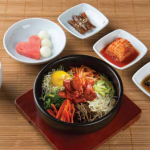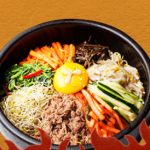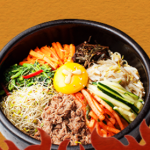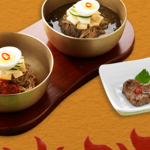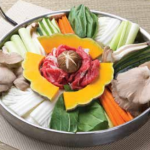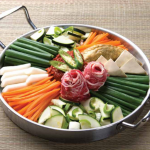Are you ready to embark on a mouthwatering journey through the colorful world of Korean cuisine? Packed with bold flavors and tantalizing aromas, Korean dishes have gained international popularity for good reason. From the sizzling Bulgogi to the satisfying Bibimbap, each dish tells a story. So, let’s dive into the key ingredients that make Korean cuisine so uniquely delicious!
Introduction: A Symphony of Flavors
Korean cuisine is renowned for combining a harmonious blend of flavors, textures, and colors that tickle the taste buds. The secret behind these delectable dishes lies within the careful selection and preparation of key ingredients, which are crucial in creating the distinct Korean taste. Let’s uncover the culinary wonders that motivate food enthusiasts worldwide to savor the flavors of Korea.
Body: Unveiling the Key Ingredients
1. Gochujang: The Fiery Heart
No Korean dish is complete without Gochujang, a spicy fermented chili paste. This vibrant and versatile ingredient adds depth and heat to various recipes. Made from red chili peppers, glutinous rice, fermented soybeans, and salt, Gochujang injects that fierce kick that Korean cuisine is renowned for. Whether used as a marinade for grilled meats or as a base for stews, it brings the zing that leaves you craving for more.
2. Doenjang: The Fermented Elixir
Doenjang, a traditional fermented soybean paste, plays a fundamental role in Korean cuisine. Its rich, earthy flavor adds depth to countless dishes and serves as the base for iconic Korean soups. Made from soybeans, salt, and water, Doenjang is aged and brimming with umami goodness. Infused with its robust and complex flavor profile, it captivates your palate, transporting you to the heart of Korea.
3. Kimchi: The Quintessential Sidekick
No Korean meal is complete without the iconic Kimchi, a spiced pickled vegetable dish. Bursting with contrasting flavors of spicy, sour, and tangy, Kimchi is a staple at every Korean table. Often made with napa cabbage, radishes, scallions, or cucumber, it is fermented with a mix of seasonings that include garlic, ginger, red pepper flakes, and fish sauce. Kimchi not only adds a refreshing crunch but also aids digestion, resulting in a satisfying culinary experience.
4. Sesame Oil: The Nutty Elixir
Sesame oil, derived from toasted sesame seeds, boasts a distinct nutty aroma and flavor that enriches Korean cuisine. It elevates the taste of numerous dishes, from stir-fries to salads and dipping sauces. With its deep amber hue and luscious consistency, sesame oil imparts an irresistible depth to Korean dishes, leaving a lasting impression on your taste buds.
5. Ganjang: The Essential Seasoning
Ganjang, also known as Korean soy sauce, permeates Korean cooking with its characteristic saltiness and savory notes. Traditionally brewed from fermented soybeans, Ganjang is far more complex than regular soy sauce. This indispensable ingredient is used in countless dishes, accentuating the flavors while imparting a distinct umami taste. Its ability to heighten the taste profile of Korean cuisine is unmatched.
Conclusion: An Unforgettable Culinary Adventure
Embarking on a journey to taste Korean cuisine means succumbing to a symphony of flavors and textures. The key ingredients like Gochujang, Doenjang, Kimchi, Sesame Oil, and Ganjang contribute to the unique and captivating essence of Korean dishes. From the fiery heat of Gochujang to the subtle nuttiness of Sesame Oil, each ingredient plays a crucial role in creating the unforgettable taste that has captivated international palates.
FAQs (Frequently Asked Questions)
1. Is Korean food usually spicy?
Yes, Korean cuisine often incorporates spicy elements through the liberal use of Gochujang, red pepper flakes, or fresh chili peppers. However, not all dishes are intensely spicy, and you can still enjoy a variety of milder options.
2. Is Kimchi always made with cabbage?
While the most common variety of Kimchi is made with Napa cabbage, there are many other versions available. Kimchi can be made with radishes, scallions, cucumbers, or other vegetables, each with its own unique flavors and textures.
3. Can I use regular soy sauce as a substitute for Ganjang?
While regular soy sauce can be used as a substitute in a pinch, Ganjang possesses a more complex flavor profile due to its traditional fermentation process. To truly capture the essence of Korean cuisine, it’s best to use Ganjang if possible.
4. Are there vegetarian options in Korean cuisine?
Absolutely! Korean cuisine offers a wide range of vegetarian-friendly dishes. Tofu-based stews, vegetable pancakes, and Bibimbap with vegetables are just a few examples of the many vegetarian delights available.
5. What are some popular Korean desserts?
Korean desserts often include sweet rice cakes called “Tteok,” which come in various flavors and shapes. Other popular desserts include “Bingsu” (shaved ice with various toppings), “Hotteok” (sweet pancakes filled with cinnamon and nuts), and “Hoddeok” (pancakes filled with gooey syrup).
So, venture into the magical world of Korean cuisine and let your taste buds revel in the exquisite flavors and aromas. From the first bite to the last, you’ll be transported to a land filled with culinary wonders and unforgettable gastronomic experiences!
Follow us for more exciting culinary adventures and explore the fascinating realm of Korean cuisine.


